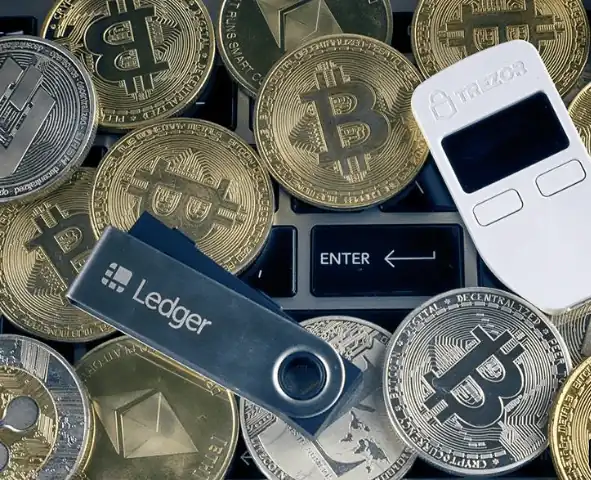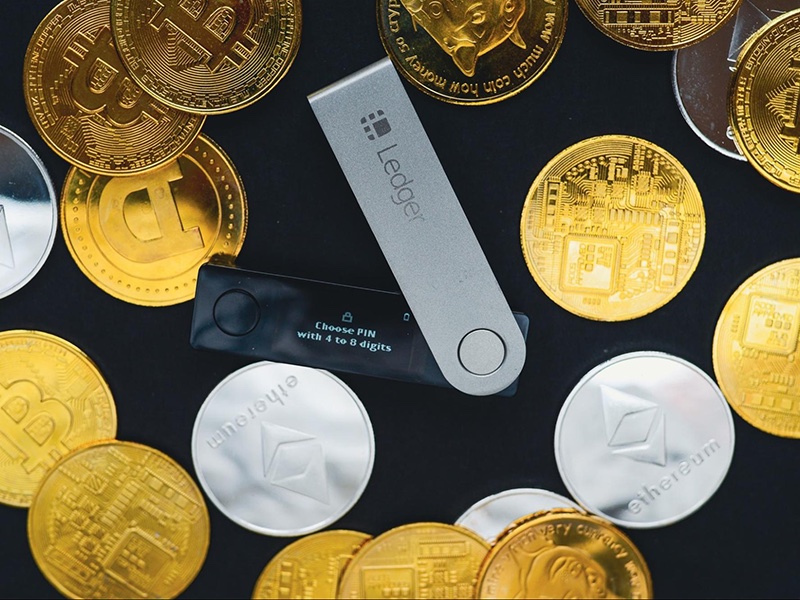In today's rapidly evolving digital landscape, the rise of digital currencies and the underlying blockchain technology has revolutionized how we perceive and transact with money. Cryptocurrencies, such as Bitcoin, Ethereum, and others, have gained widespread popularity and value, attracting diverse investors and users worldwide. However, this surge in interest comes with an increased risk of theft, hacking, and unauthorized access to these valuable digital assets. Securing your digital holdings has become more critical than ever before. By understanding and utilizing cold wallets, individuals can safeguard their digital assets and have peace of mind in an era characterized by escalating cyber risks. As the value and popularity of cryptocurrencies continue to soar, it is crucial to prioritize the security of your digital assets. Cold wallets provide an effective and secure solution by keeping your private keys offline and out of reach from potential online threats. By utilizing cold wallets, individuals can confidently protect their digital holdings, maintain control and ownership, and navigate the ever-changing landscape of digital currencies with peace of mind.
Understanding the Functionalities of Cold Wallets
In this section, we will explore the functionalities of cold wallets, including the generation of private keys, secure storage, transaction signing, transaction approval, and the broadcasting of transactions to the blockchain network. Understanding how cold wallets work is essential for individuals looking to safeguard their cryptocurrencies and maintain control over their private keys. Here's how a cold wallet typically works:
Generating Private Keys:
To begin using a cold wallet, you set up and generate a new wallet or import an existing one onto the device. The cold wallet generates a unique pair of public and private cryptographic keys during this process. The public key serves as the wallet's address for receiving funds, while the private key grants ownership and control over the associated digital assets.
Secure Storage:
Once the private keys are generated, they are securely stored within the cold wallet device or on an offline storage medium like a USB drive or a paper wallet. Hardware wallets often incorporate built-in secure elements and specialized chips to protect private keys from physical and software attacks.
Transaction Signing:
Connect the cold wallet device to a computer or mobile device to initiate a transaction or access your digital assets. The connection is typically established using a USB cable or Bluetooth. The cold wallet's software interface allows you to interact with the wallet and sign transactions using your private key.
Transaction Approval:
When a transaction is initiated, the cold wallet software prepares the transaction details, including the recipient's address and the amount to be sent. The transaction is securely transferred to the cold wallet device for approval. The device digitally signs the transaction using the offline private key, creating a unique cryptographic signature that verifies the transaction's authenticity and integrity.
Broadcasting the Transaction:
Once the transaction is signed, it is transmitted back to the computer or mobile device and can be broadcasted to the blockchain network. The transaction and the digital signature are added to a block and validated by the network's consensus mechanism, ensuring the transaction's legitimacy and authorization by the owner of the private key. Keeping the private keys offline and securely stored within the cold wallet device significantly reduces the risk of unauthorized access or theft. Even if the computer or mobile device used for transaction signing is compromised, the private key remains safe within the wallet, providing additional protection for your digital assets.

Types of Cold Wallets
Different types of cold wallets are available, each offering different approaches to offline storage. Let's explore two common examples:
Hardware Wallets:
These are physical devices designed to store private keys offline. Hardware wallets are often shaped like USB drives and have security features, including PIN codes, encryption, and built-in screens for transaction verification.
Paper Wallets:
A paper wallet involves printing or writing down your private keys (seed phrases) on paper or metal sheets. It is an entirely offline method of storing digital assets. Paper wallets can be generated using dedicated software applications or online services, which create a pair of keys to be printed and used as a physical representation of your digital assets. However, ensuring the security and proper handling of the printed paper wallet is vital.
Hardware wallets and paper wallets are two commonly used types of cold wallets. Hardware wallets offer the convenience of securely storing private keys on a physical device, while paper wallets provide an offline method by writing or printing private keys on paper. Choosing the correct type of cold wallet depends on individual preferences and requirements. By opting for a cold wallet, users can enhance the protection of their cryptocurrencies and have peace of mind knowing that their assets are stored offline.
Advantages of Using Cold Wallets
Using cold wallets for storing and managing your digital assets offers several distinct advantages. One of the primary benefits is enhanced security. By keeping your private keys offline, cold wallets provide the highest level of protection for your digital assets. This ensures your funds are shielded from potential online threats, such as hackers, malware, or phishing attacks. Additionally, cold wallets offer protection from the various risks associated with online storage. Since they are not connected to the internet, cold wallets are immune to vulnerabilities in online environments. This significantly reduces the risk of unauthorized access, theft, or loss of funds, providing you with added peace of mind. Another advantage of using cold wallets is the level of control and ownership they afford. By having exclusive control over your private keys, you are not reliant on third-party custodians or exchanges to safeguard your assets. This independence enhances the overall security of your digital assets and ensures that you always have complete control over your funds. Despite their advanced security features, cold wallets are designed to be user-friendly. They provide intuitive interfaces that make managing and transacting with your cryptocurrencies a seamless experience. You can easily view your balances, initiate transactions, and monitor your assets while maintaining high security. Cold wallets offer enhanced security, protection from online risks, greater control and ownership, and a user-friendly experience. These advantages make them a preferred choice for individuals seeking the utmost security and control over their digital assets.
Exploring the Drawbacks of Cold Wallets
While cold wallets offer enhanced security for storing cryptocurrencies, there are a few potential disadvantages to consider:
Complexity:
Cold wallets typically involve more technical knowledge and setup than online or software wallets. They often require offline devices, additional software, and steps like creating and storing backup seeds or private keys. This complexity may discourage less tech-savvy users or those looking for convenience.
Accessibility:
Since cold wallets are offline devices, they can be less accessible compared to online wallets. You must connect the cold wallet to a computer or mobile device to access your funds or transact. This extra step may be better for users who frequently need to interact with their cryptocurrency holdings.
Transaction Speed:
When using a cold wallet, executing transactions can be slower than online wallets. Since cold wallets are offline, you'll need to connect them to a device and manually sign transactions, which can take longer. This delay might be inconvenient for users who require quick and frequent transactions.
Risk of Physical Damage or Loss:
Cold wallets are devices that can be susceptible to physical damage or loss. Proper storage and backup strategies are essential to mitigate this risk, but it remains a concern. However, you can access your funds with your 24-word seed phrase to recover your funds on a new cold wallet.
Cost:
Compared to online or software wallets, cold wallets often come with a price tag. While some basic models may be affordable, more advanced and feature-rich options can be relatively expensive. This cost factor might deter users unwilling to invest in a separate hardware wallet. It's important to note that despite these potential disadvantages, cold wallets are widely regarded as one of the most secure ways to store cryptocurrencies. Their offline nature and added security measures make them a preferred choice for individuals concerned about the safety of their digital assets.
Best Practices for Cold Wallet Usage
To maximize the security benefits of using cold wallets, it is essential to follow best practices that ensure the safety of your digital assets. Firstly, always purchase cold wallets from authorized and reputable sources to ensure the authenticity and integrity of the device. Avoid purchasing from third-party sellers or unauthorized resellers. Secondly, set up strong and secure PIN codes and passphrases for your wallet device to protect against unauthorized access. Create a combination of letters, numbers, and symbols to form a robust passphrase. Regularly backing up your wallet is crucial. Safely store a copy of your private keys or recovery seed phrase in a separate physical location. This lets you recover your digital assets even if the wallet is lost or damaged. Stay updated with the latest firmware and software releases the wallet manufacturer provides. These updates often include security enhancements and bug fixes, ensuring your wallet remains secure against emerging threats. Before finalizing any transaction, testing and verifying the details on the wallet's screen is essential. Carefully review the recipient's address and the amount sent to prevent unintended transfers. By following these best practices, you can enhance the security of your wallet usage and safeguard your cryptocurrencies with peace of mind.
PlasBit: Secure Alternative to Cold Wallet
We provide advanced security features and protocols to ensure user funds' safety. Our platform is designed to provide a secure and reliable solution for storing and managing your assets.
Robust Security Measures:
Our Wallet is equipped with advanced security infrastructure to protect your assets. We employ robust encryption techniques to secure your private keys, ensuring that only you can control your funds. Our wallet also supports additional security measures such as biometrics and 2-Factor Authentication, adding an extra layer of protection to your account.
Wide Range of Supported Cryptocurrencies:
With our Wallet, you can conveniently manage various cryptocurrencies in one place. Our wallet supports popular cryptocurrencies like Bitcoin (BTC), Ethereum (ETH), Litecoin (LTC), Cardano (ADA), ERC20 tokens, Tron (TRX), and USDT TRC20. This broad support enables you to store, track, and manage multiple digital assets within a secure wallet.
User-Friendly Interface:
We have designed our Wallet with a user-friendly interface to ensure a seamless experience for novice and experienced users. The wallet's intuitive design lets you easily view your balances, monitor transactions, and initiate transfers with just a few clicks. We prioritize simplicity and convenience to enhance your overall wallet management experience.
Offline Storage for Enhanced Security:
Our Wallet incorporates offline storage solutions to provide enhanced security for your cryptocurrencies. We minimize the risk of unauthorized access or hacking attempts by storing your assets offline in secure deposit boxes and vaults worldwide. Offline storage adds a layer of protection, ensuring the safety of your digital assets.
Private Key Encryption:
We understand the importance of protecting your private keys. Our Wallet utilizes advanced encryption algorithms to encrypt your private keys, ensuring they remain secure and inaccessible to unauthorized individuals. By encrypting your private keys, we maintain the confidentiality of your assets and empower you with complete control over your funds.
Get Started with PlasBit
Registering on PlasBit and using our secure wallet solution requires an email address and a password. Follow these simple steps to register and create your account on PlasBit:
Visit our Website’s Designated Registration Page:
Click the Get Started button at the top right corner of your browser leading to our designated registration page.
Enter your email address:
Provide your email address in the registration form. This will serve as your username for logging into your account.
Choose a strong password:
Create a secure password that combines uppercase and lowercase letters, numbers, and special characters. This password will be used to protect your account and access your wallet.
Verify your email:
After submitting the registration form, check your email for our verification link. Click on the link to verify your email address and activate your account.
Set up additional security measures (optional):
To enhance the security of your account, consider enabling additional security features offered by us at PlasBit, such as two-factor authentication (2FA) or biometric authentication if supported by your device.
Access your PlasBit wallet:
Once your account is activated, log in to your account using your registered email address and password. You will gain access to your secure wallet interface, where you can view your balances, manage your digital assets, and explore the various features. Following these simple steps, you can quickly register and create your account on our platform. Once you've completed the registration, you'll gain access to your wallet, where you can manage your digital assets and explore the various features available on our platform.
Final Thoughts
As the popularity and value of cryptocurrencies continue to rise, the need for secure storage solutions has become increasingly critical. Cold wallets are a reliable and effective method for protecting digital assets against hacking, theft, and online vulnerabilities. The various types of cold wallets available cater to different security preferences, ensuring users can find a suitable option that meets their needs. Hardware wallets provide physical, tamper-resistant devices with robust security features, making them popular for beginners and experienced users. Paper wallets offer an offline, easy-to-create option, although they require proper handling and storage to prevent physical damage or loss. Offline software wallets provide an additional layer of security by generating and storing private keys on computers disconnected from the internet. Individuals can maintain complete control and ownership of their private keys by opting for cold wallets, eliminating the need to rely on third-party custodians or exchanges. This self-custody approach significantly reduces the risk of unauthorized access or theft of digital assets, providing peace of mind to cryptocurrency holders. It's important to emphasize the importance of adhering to best practices when using cold wallets. Regularly updating firmware or software, implementing strong PIN codes and passphrases, and securely backing up private keys or recovery seed phrases are essential to ensure the long-term security and accessibility of stored digital assets. Cold wallets remain crucial for protecting investments and controlling digital assets as the cryptocurrency ecosystem evolves. By embracing cold wallet technology and staying informed about emerging security practices, users can confidently navigate the digital landscape while safeguarding their financial future. Remember, in the world of cryptocurrencies, taking ownership and securing your private keys is the key to maintaining control and ensuring the safety of your valuable digital assets. With cold wallets as your fortress, you can embark on your cryptocurrency journey with peace of mind, knowing that your investments are protected against online threats and vulnerabilities. By adopting cold wallets, you take a significant step towards protecting your digital assets and ensuring a secure cryptocurrency future.







